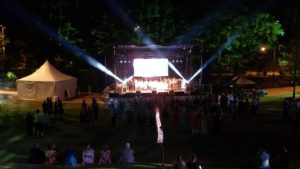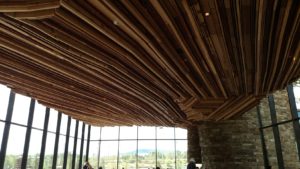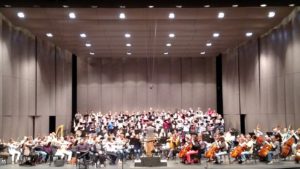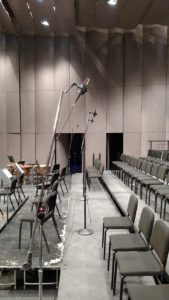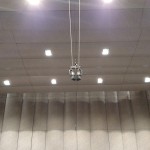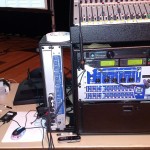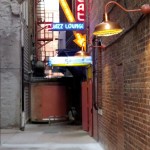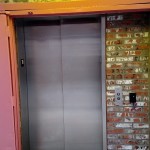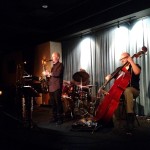This week at the Tulsa Performing Arts Center, we have the Oklahoma Music Educators Association (OMEA) “All-State” Music Conference in the building. This is the primary music education advocacy group for all school music programs, from elementary through college, in the state of Oklahoma. They take over most of the hotels and convention space in downtown Tulsa for a good four days in about the 3rd week of January every year. This includes our building where the All-State Band, Orchestra and Mixed Chorus rehearse for two long days and then perform on Saturday along with the Women’s Chorus and the Wind Symphony. An All-State Children’s Chorus and an All-State Jazz Band rehearse and perform at other venues in downtown Tulsa. For us it involves one day to set up in every room that we have and then three long 16-hour days in a row while the groups are rehearsing and performing. It’s an exhausting week.
I’m always a little nostalgic during OMEA, because I happen to have been a member of the All-State Band in 1998. It was my first time setting foot on stage at the Tulsa Performing Arts Center and it was a little intimidating and somewhat awe inspiring. Nowadays, I know every nook and cranny of the building like the back of my hand and being back stage before, after, and during a show is nothing special. I’ve done it literally thousands, maybe even tens of thousands of times now.
To earn a spot in one of the All-State ensembles, students undertake a competitive audition process in the fall of every year. For the band and orchestra students, this is a very long and arduous process and involves as many as four rounds of auditions over a couple of months and is extremely competitive depending on what instrument they play. Those that are talented and fortunate enough to earn a spot in the All-State ensembles are often sought after by colleges and universities and offered talent based scholarships to play music in college. For many of them it is the fulfillment of years of hard work, thousands of hours of practice and private lessons, and the culmination of their high school music careers. They get to spend three days working with nationally and internationally renowned conductors and clinicians and play some of the best music literature in the field with the best of their peers. These kids are the best musicians in high school in the state of Oklahoma. A very select few earn a spot in the All-State ensembles three years in a row; these students are the best of the best.
My senior year of high school, ’97-’98, I was fortunate enough to earn a spot in the All-State Band (actually I earned two spots, more about that in a bit). I got to perform on stage at the Tulsa Performing Arts Center with the Oklahoma All-OMEA Band in January of 1998, 20 years ago almost to the day. I played 2nd chair tenor saxophone in the OMEA All-State Band. This was for me the culmination of my high school music career and signaled a transition to my efforts as a saxophone performance major in college. It was the end of three years of hard work with two different saxophone teachers and many thousands of hours of practice and dedication. I’m sure that I annoyed the hell out of my parents and siblings practicing for hours and hours non stop as much as I could. For three years I was focused on this singular goal of “making All-State”. And it paid off.
The saxophone auditions for All-State are one of the more grueling audition processes. Because there are a fair number of saxophone players in the high school band programs all across the state there are a lot of players that try to earn a spot in the All-State Band. And they only take up to eight players total: four altos, two tenors and two baritones. But they don’t have to take all of those slots if there are not enough qualified players. So, if you are one of the hundreds, or even thousands of alto saxophone players in the state, you have to compete against everyone else for just one of four slots. And to do that, you have to make it through four different rounds of auditions: two at the first round of auditions in October or early November (usually at your all-region honor band auditions), and two more in December at the final round of All-State auditions. And then there are a few masochistic players who take upon themselves the burden of auditioning on more than one instrument. I was one of those players!
This was my secret weapon. Every year I auditioned on alto, tenor and baritone saxophones. They had the same music and playing the different saxophones is not really that difficult once you make some minor adjustments in your embouchure and hand position. So, every year, here I was lugging around nearly 80 lbs of saxophones and saxophone cases, my music bag and music stand and whatever else I had with me. This was in the days before teenagers had cell phones surgically attached to their hands and faces. I did usually have a Sony Walkman and later a Discman music player and head phones with me though. I almost never bothered to bring any text books or study materials with me on band trips or music auditions because, well, why bother? That would negate all the fun that you have on these trips.
Let me stage the stage for you:
In the fall of 1997, I was a senior in high school. I was 18 years old (so legally an adult now), had spent the summer working for MerCruiser building boat engines, and played first chair alto saxophone in the marching band that fall. I detested marching band. Hated it with a passion unequaled to any and viewed it as not only a hindrance to any legitimate musical endeavor, but actually the antithesis of art. All the good that the arts do, football and marching band undoes. My band directors were none to keen with my view of the primary function of their job with the public school district. I had on numerous occasions been threatened with expulsion from the band program or the after school jazz band because of my attitude. At one point, I failed to have my marching band music memorized. My band director called me into his office and chewed me out and chastised me for being the section leader and not having my music memorized. I told him that I was concentrating on learning my All-State audition music. He was furious, and demoted me to last chair alto saxophone. I only laughed a little. But a week or so later I finally had it all memorized. I don’t remember if I even bothered to try to get back to 1st chair or not, since I viewed being 1st chair in marching band as a dishonor any way. On to the All-State auditions.
Three years in a row I auditioned for All-State. Every year I made it through the first two rounds of auditions in October to the final auditions in December. I figured that I should increase my chances by auditioning on all three saxophones, since they have the same music. (The OMEA committee has since separated the audition music for saxophone, so each instrument has different selections, which makes it harder to audition on all three saxophones since you have to learn six different very hard pieces). The final round of auditions is in itself an exhausting process. It always happens on the first Saturday in December at West Moore High School in Moore, Oklahoma, one of the biggest high schools in the state. Auditions start promptly at 08:00 (that’s 8:00 am for most of you). Every student has to draw a number to get their audition spot. If you are late: you’re disqualified. So you have to be at the school and registered for the auditions by no later than 7:30 am, which means that you show up about 7:00 am. Because our school was a good two hours away, we always stayed in a hotel in Moore the Friday night before so we would have a shorter commute the morning of the auditions. Our school always had a good dozen or so students that made it to the final auditions in December.
We would drive down after school on Friday, check in to our hotel rooms and then go to dinner and spend some time wandering around the local mall. My room mate on these nights was one of my best friends and clarinet player Michael Miller. We had a great time and it was a tradition of ours to buy a music CDs on these trips. One of these years, I think my sophomore year (1995), I bought my first Tower of Power CD T.O.P. and would form the basis of a life-long passion for the East-Bay soul and funk sound that is Tower of Power. This is one of those rare examples in public school where your teachers begin to make it appear that they might think about treating you, sort of, like an adult. They expect you to be somewhat responsible to get your butt to the bus and audition rooms on time without constant micromanaging, a privilege earned through the long practice and audition process.
In December of 1996, when I failed to earn a spot in the All-State Band, I knew I had to make some changes. It took a couple of months, but in February of 1997 I did something that would change my life forever. I found a saxophone teacher. And not just any saxophone teacher, the best saxophone teacher and most talented classical saxophonist in the entire state of Oklahoma: Linda Naylor, the adjunct professor of saxophone at The University of Tulsa. She was and is one of the most important people in my life and taught me more about music and life than almost any other single person in my life. She once told me that, after my first lesson with her, she thought to herself, “oh my god, what have I gotten myself into?” But she stuck with me. She changed everything about how I played the saxophone: my embouchure, hand position, breath control, reading skills, listening skills, counting, musical interpretation, even the length of my neck strap. EVERYTHING. She taught me how to play the saxophone. After six years of abysmal public school music education, she taught me how to actually play music. And even now when I teach my own daughter how to play her flute, I hear Linda’s voice coming out of my mouth. Using the same expressions and terminology to describe what all the various music terms and techniques are.
Linda, if you are reading this: I can’t thank you enough for what you did for me over 4 and a half years. You took me under your wing and taught me more than any other single teacher, and more than most put together. You were the biggest influence on my life after my parents, and now I get to pass those lessons down to my own daughter.
So in December of 1997, I walk into the All-State auditions armed with a head full of new knowledge about how to play the saxophone and with nearly a year of intense saxophone lessons under my belt. I was confident and hopeful as I drug my three saxophones into West Moore High School. I had a plan. I had been working on the audition music, other etudes, solos, and sight reading with Linda for nearly a year now. I won’t go as far as saying that I could see the future, but I was pretty damn confident in the work that I had put in. And more than that, I was dead set on proving to my band director that the guy that he demoted a few weeks earlier to last chair was going to make All-State. I was focused on this singular task like a laser beam, cutting it down piece by piece.
There’s a process to the process of auditioning:
First: You have to put in the work. You’ve got to know the music forwards and backwards, at faster and slower tempos than what is marked. At this point, I could play my audition pieces from memory. But, I always used the music because the audition required different portions of the music to be played, so I had to make sure I was playing the correct segments of the music.
Second: On the day of the audition, you have to stay focused. Don’t let yourself get distracted by whatever is going on around you. Don’t run off with friends or get carried away chatting about whatever nonsensical thing teenagers talk about. Stay focused on the audition. That’s your job. You can have fun after the audition is over and you are waiting to hear the results.
Third: Do not, DO NOT play your audition piece in the warm up room. You’re tipping your hand to the other players if you do. Run some scales and chords, play something else, get some decent long tones in. You want a good solid warm up. And normally, the first time you play your audition piece is the best run you get out of that day. So save it for the audition room.
Forth: Be cool. Stay relaxed. Be confident, but not arrogant. And don’t get nervous. You’ve played this piece hundreds of time before, this is just another run.
All-State audition day at West Moore High School can best be described as barely controlled chaos. There are thousands of students there all hanging out in the gym, cafeteria, commons area and hall ways. The students from each school find an area to camp out for the nearly 16 hour long day. Pillows, coats, book bags, instrument cases and folding music stands litter every available piece of real estate possible. Your fellow students are charged with watching over each other’s stuff while everyone goes to their warm ups and auditions. It’s a base camp of sorts for the day.
When I get to the gym to warm up for my first round of auditions, I run some scales and some long tones. Play some other etudes and one of the pieces that I am looking at for my solo contest later in the spring. Then I notice one of the other girls playing saxophone, trying to learn her audition music at the last minute. She’s playing some cheap knock off alto saxophone and has Christmas tree garland wrapped around the keys of her saxophone and a big golden tree ornament hanging from the key guard. I think to myself, “Well, there’s one other person I don’t have to worry about”.
Throughout the course of the day I warm up and play my auditions four times: two for alto and one each for tenor and baritone. The year I auditioned, there were 92 alto saxophones auditioning. And I think 21 or 22 tenors and 16 baritone saxophones auditioning. (Remember earlier when I said they only take four altos, and two tenors and baritones each?) I’m pretty sure that my success was sheer luck and came down to the sight reading. I distinctly remember walking out of my tenor audition thinking, “Man, I NAILED that sight reading!” I don’t know what it was, if it was just the right tempo that I chose, not too fast to tangle up my fingers, and not too slow to make it apparent that I couldn’t play it, or it that it just laid under my fingers just right.
After all of the auditions for each section have been completed and the scores tabulated, the results are posted, section by section, on the inside window of the main office of the school. About mid afternoon when the smaller sections have completed their audition process, everyone starts gravitating towards the main office of the school to wait for the results. And cheers erupt each time a section is posted as kids see the final results. Some dreams are made. Lots of hearts are broken.
There’s this magical moment during the day, when one of the people working on tabulating the scores comes out of the office before the scores are posted and they yell through a bull horn that they need to see such and such student. That student is summoned to the office because they auditioned on more than one instrument and they made it on more than one instrument, so they have to decide which one they are going accept. That student gets to hear the results of their audition before everyone else does. But, that simple announcement of calling them to the office announces to everyone that they made it. If you are one of those students, you are greeted with high-fives, pats on the back and fists in the air as you walk to the office to pick your instrument.
For me, this happened about 6:00 in the evening. Now remember, we had been up since about 5:30 am and at West Moore since about 7:00 am. And four auditions and 11 hours later I found myself walking into the tabulation office. My band director is in the back with a shit-eating grin on his face, and one of the other directors tells me that I made 2nd chair tenor saxophone and 2nd chair baritone saxophone in the All-OMEA Band. Before he could even ask which one I wanted, I told him, “I’ll take tenor!”. He says, “Ok, please don’t tell anyone until the results are officially posted”. Yeah…fuck that noise! As I walk out of the office, my friends from my high school band are all standing there: word has gotten out. My buddy Mike asks, “well, which one is it?” “2nd Tenor!” More high-fives and cheers were to be had.
The adrenaline rush keeping you going all day through this process begins to drain away and you start feeling dead tired all of the sudden. You find a place to nap until the rest of the students in your school are done and everyone is ready to leave. That year we had four students from our band that made it to the All-State Band and Orchestra and two alternates. A pretty good showing for our school at that time. My friend Mike also made it to the All-State Band on clarinet. So, we got to room together during the festival.
A week or so later you get your official paperwork and music in the mail for the All-OMEA Festival in January. You start practicing a new round of music. And this stuff is hard. Really hard. Like REALLY damn hard. The hardest stuff you’ve ever played. More intense lessons with Linda to get me ready to play the music in the festival.
The week of the Festival rolls around. We get two days off school. The school paid for our hotel rooms and food for the three days we are at the OMEA Festival. It’s an intense three days of hard playing and rehearsing. You spend ALL DAY in rehearsal except for a few breaks. Now, I was playing at lot at this point in my life, usually about three hours a day during the week and up to five hours a day on the weekends. But most high school music students don’t play anywhere near that amount and certainly not at this level. By the end of the first day all of the brass players and double reed players were nearly dead, and we had two more days to go! Even I wasn’t quite ready to spend eight or nine hours playing in a single day. My chops were shot by the end of the second day and I barely made it through the concert.
At some point on Friday I turned to my friend Mike and said, “Hey, do you realize we haven’t seen our band directors since Wednesday night?”. He says, “Yeah, I was thinking about that earlier.” Here we are, on a school sponsored trip and we haven’t seen our teachers in almost two days. It was the first time that I had been treated like an adult by any school teacher ever. I guess they expected that the level of maturity to take the time and effort required to make it to All-State meant that we could be afforded the rights that we deserved. We were literally on our own for a good three-days to get up and get to rehearsals and meals on our own. I wouldn’t experience this level of respect by educators again for more than another year until I went on tour with the TU Jazz Band my freshman year of college–but that’s another story.
I don’t actually remember much about the concert. But, one thing I do distinctly remember is siting in rehearsal on the Chapman Music Hall stage. While the conductor was working with one of the other sections for a few minutes I was looking around, and noticed a giant gaping hole downstage in front of where we were playing. I could have sworn that there wasn’t a hole there earlier. Then a few minutes later, I see some guys coming up through that floor. They were riding the automated pit lift up with some piece of equipment or another. It was the first time I had seen a movable orchestra pit. The day of the concert, we played some music. And then it was over. Once again that adrenaline rush subsided and we had dinner after the concert and went home. And then, we had to go back to playing in our regular high school band, which was kind of a let down after playing in the All-State Band.
The equipment I used for the All-State Band auditions and concert:
King Super 20 tenor saxophone
Selmer S80 C** mouthpiece
Vandoren V16 #4 reeds
20 years ago, I thought my path would take me to being a professional saxophone player or teacher. But, here I am, 20 years later: a professional audio engineer sitting in the sound booth of the Tulsa Performing Arts Center turning microphones on and off for the All-State concerts as another generation of young music students pursues their own life in music. It’s been a long few days and I have lost a full night’s sleep over the last three nights. But, I wonder if I was destined to be here..to work in the same building that started me down this path of working as a professional in the arts and entertainment industry.
I don’t get to play anywhere near as much as I want to these days. Working 60 and 70 hour long weeks for multiple weeks in a row at the Tulsa PAC and family responsibilities doesn’t afford me the free time to dedicate to my first love. I still consider myself a saxophone player above, beyond, and before all else. But, every year I tell myself, “This year. This year, I’m going to hit the woodshed and get my chops in shape and find a band to play with.” And then I never find the time.
Well, maybe this year will be the year, finally.


